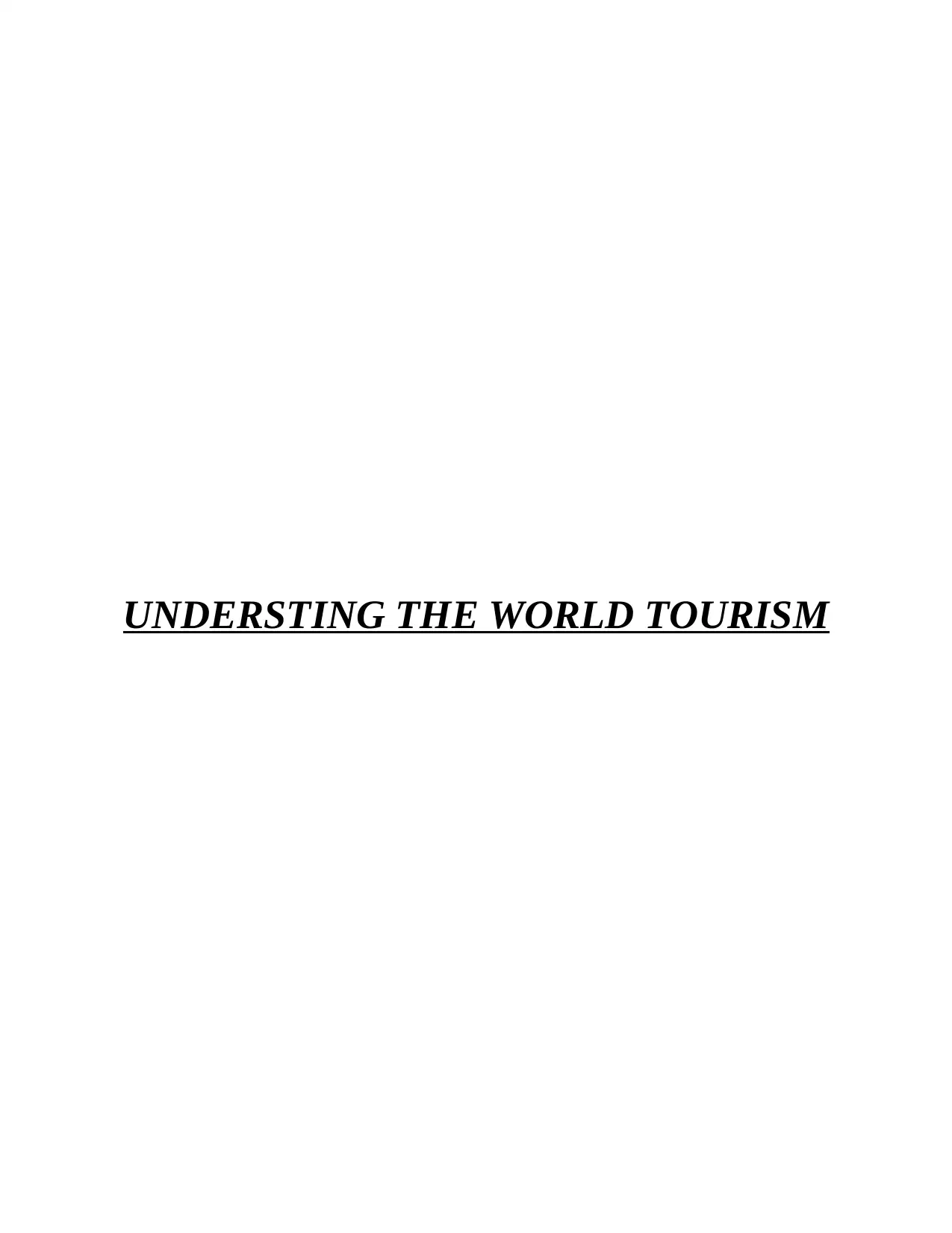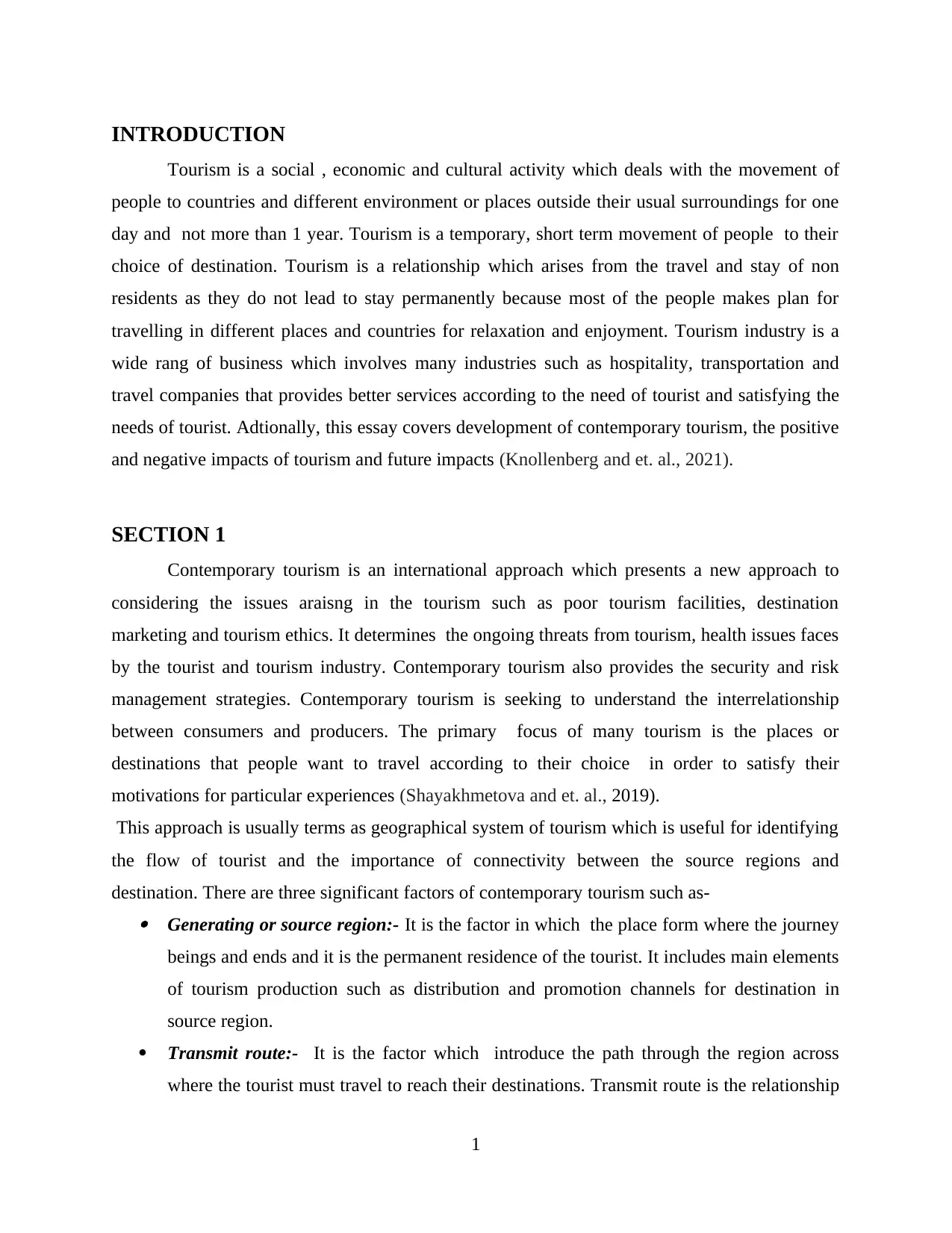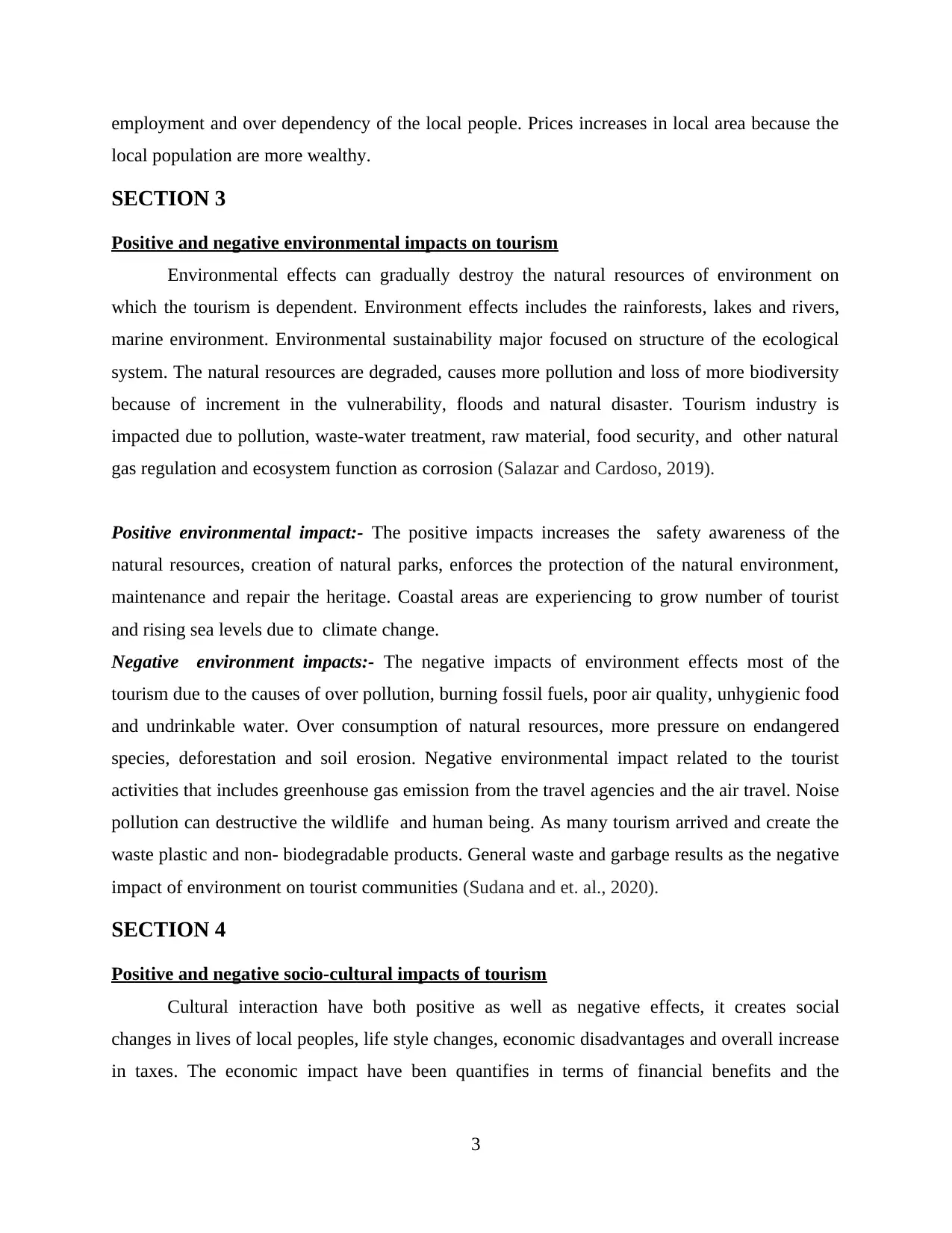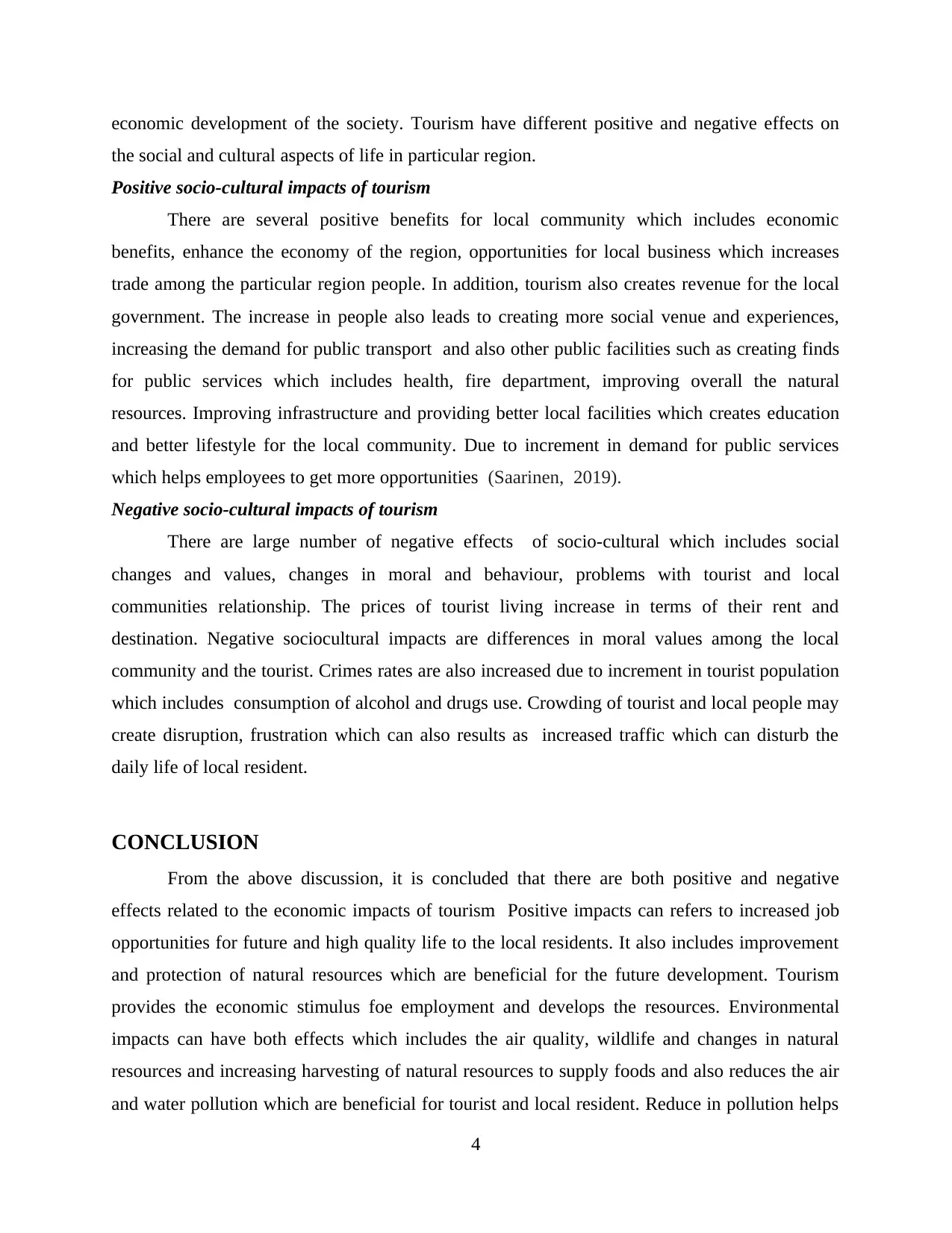A Comprehensive Analysis of the Impacts of World Tourism Development
VerifiedAdded on 2023/06/09
|8
|1965
|316
Essay
AI Summary
This essay provides a detailed analysis of world tourism, focusing on its economic, environmental, and socio-cultural impacts. It begins by defining contemporary tourism and its key components, including generating regions, transmit routes, and destination regions. The essay then delves into the positive and negative economic impacts, such as employment opportunities, increased tax revenues, and potential economic leakage due to foreign ownership. Furthermore, it examines the environmental impacts, highlighting both the benefits of conservation efforts and the detrimental effects of pollution and resource depletion. Finally, the essay discusses the socio-cultural impacts, noting both the potential for cultural exchange and economic benefits for local communities, as well as the risks of social disruption and increased crime rates. The conclusion summarizes the multifaceted nature of tourism's impacts, emphasizing the need for sustainable development practices to maximize benefits and mitigate negative consequences. This essay provides a comprehensive overview for students; Desklib provides similar past papers and solved assignments.

UNDERSTING THE WORLD TOURISM
Paraphrase This Document
Need a fresh take? Get an instant paraphrase of this document with our AI Paraphraser

Table of Contents
INTRODUCTION...........................................................................................................................1
SECTION 1......................................................................................................................................1
SECTION 2 .....................................................................................................................................2
Positive and negative economic impact on tourism...............................................................2
SECTION 3......................................................................................................................................3
Positive and negative environmental impacts on tourism......................................................3
SECTION 4......................................................................................................................................3
Positive and negative socio-cultural impacts of tourism........................................................3
CONCLUSION................................................................................................................................4
REFERENCES ...............................................................................................................................6
INTRODUCTION...........................................................................................................................1
SECTION 1......................................................................................................................................1
SECTION 2 .....................................................................................................................................2
Positive and negative economic impact on tourism...............................................................2
SECTION 3......................................................................................................................................3
Positive and negative environmental impacts on tourism......................................................3
SECTION 4......................................................................................................................................3
Positive and negative socio-cultural impacts of tourism........................................................3
CONCLUSION................................................................................................................................4
REFERENCES ...............................................................................................................................6

INTRODUCTION
Tourism is a social , economic and cultural activity which deals with the movement of
people to countries and different environment or places outside their usual surroundings for one
day and not more than 1 year. Tourism is a temporary, short term movement of people to their
choice of destination. Tourism is a relationship which arises from the travel and stay of non
residents as they do not lead to stay permanently because most of the people makes plan for
travelling in different places and countries for relaxation and enjoyment. Tourism industry is a
wide rang of business which involves many industries such as hospitality, transportation and
travel companies that provides better services according to the need of tourist and satisfying the
needs of tourist. Adtionally, this essay covers development of contemporary tourism, the positive
and negative impacts of tourism and future impacts (Knollenberg and et. al., 2021).
SECTION 1
Contemporary tourism is an international approach which presents a new approach to
considering the issues araisng in the tourism such as poor tourism facilities, destination
marketing and tourism ethics. It determines the ongoing threats from tourism, health issues faces
by the tourist and tourism industry. Contemporary tourism also provides the security and risk
management strategies. Contemporary tourism is seeking to understand the interrelationship
between consumers and producers. The primary focus of many tourism is the places or
destinations that people want to travel according to their choice in order to satisfy their
motivations for particular experiences (Shayakhmetova and et. al., 2019).
This approach is usually terms as geographical system of tourism which is useful for identifying
the flow of tourist and the importance of connectivity between the source regions and
destination. There are three significant factors of contemporary tourism such as- Generating or source region:- It is the factor in which the place form where the journey
beings and ends and it is the permanent residence of the tourist. It includes main elements
of tourism production such as distribution and promotion channels for destination in
source region.
Transmit route:- It is the factor which introduce the path through the region across
where the tourist must travel to reach their destinations. Transmit route is the relationship
1
Tourism is a social , economic and cultural activity which deals with the movement of
people to countries and different environment or places outside their usual surroundings for one
day and not more than 1 year. Tourism is a temporary, short term movement of people to their
choice of destination. Tourism is a relationship which arises from the travel and stay of non
residents as they do not lead to stay permanently because most of the people makes plan for
travelling in different places and countries for relaxation and enjoyment. Tourism industry is a
wide rang of business which involves many industries such as hospitality, transportation and
travel companies that provides better services according to the need of tourist and satisfying the
needs of tourist. Adtionally, this essay covers development of contemporary tourism, the positive
and negative impacts of tourism and future impacts (Knollenberg and et. al., 2021).
SECTION 1
Contemporary tourism is an international approach which presents a new approach to
considering the issues araisng in the tourism such as poor tourism facilities, destination
marketing and tourism ethics. It determines the ongoing threats from tourism, health issues faces
by the tourist and tourism industry. Contemporary tourism also provides the security and risk
management strategies. Contemporary tourism is seeking to understand the interrelationship
between consumers and producers. The primary focus of many tourism is the places or
destinations that people want to travel according to their choice in order to satisfy their
motivations for particular experiences (Shayakhmetova and et. al., 2019).
This approach is usually terms as geographical system of tourism which is useful for identifying
the flow of tourist and the importance of connectivity between the source regions and
destination. There are three significant factors of contemporary tourism such as- Generating or source region:- It is the factor in which the place form where the journey
beings and ends and it is the permanent residence of the tourist. It includes main elements
of tourism production such as distribution and promotion channels for destination in
source region.
Transmit route:- It is the factor which introduce the path through the region across
where the tourist must travel to reach their destinations. Transmit route is the relationship
1
⊘ This is a preview!⊘
Do you want full access?
Subscribe today to unlock all pages.

Trusted by 1+ million students worldwide

between source region and destination which includes aviation services, cruise, train and
bus services. Transmit facilities are also provides food , accommodation , separate toilets
where the tourist want to stop according to their choice of final destination (Romão,
2018).
Destination region:- This factor determines the region of tourist choice to visit and it is
the essential element of tourism. The main elements of the destination regions includes
facilities and attraction due to the facilities provided for tourism such as accommodation,
exhibitions, local transport facilities, Visitors centres and restaurants.
SECTION 2
Positive and negative economic impact on tourism
Tourism have both negative and positive impact on destination of tourist. The economic
effects on tourism includes employment opportunities, increment in standard of livings ,
improvement in tax revenues and personal wages. The fundamental component of economic
impact on tourism is that they generate with the country's borders and enacted by the residents
and non residents for business purpose. The positive and negative effects on communities are
related to the economic impact on tourism (Sokhanvar, 2019).
Positive economic impacts- The positive impact are the happiness and well-being of the
communities or the tourist. A positive impact of economic includes the high quality life to the
tourist communities, increment in jobs and provides the wealthy environment. Tourism has the
advantage of restoring the historical sites and also make the better tourist destination. Tourist
enjoys the choice of destination when the improvement in environment such as waste treatment
plan, well-developed resources within the tourism industry which helps to attract the tourist and
increases the economic structure (Nathaniel and Ahmed, 2021).
Negative economic impacts:- Negative impacts are the effects which occurs as the population
increases the natural resources becomes unsustainable and exhausted. Tourist will not agree to go
at polluted environment. Foreign ownership creates leakage which declines the opportunities for
local communities to make the profit. Foreign companies hire non resident workers and pay
them lower wages which can affect further contributes to economic leakage. The most
significant factor of negative economic impacts of tourism is to decrease the traditional
2
bus services. Transmit facilities are also provides food , accommodation , separate toilets
where the tourist want to stop according to their choice of final destination (Romão,
2018).
Destination region:- This factor determines the region of tourist choice to visit and it is
the essential element of tourism. The main elements of the destination regions includes
facilities and attraction due to the facilities provided for tourism such as accommodation,
exhibitions, local transport facilities, Visitors centres and restaurants.
SECTION 2
Positive and negative economic impact on tourism
Tourism have both negative and positive impact on destination of tourist. The economic
effects on tourism includes employment opportunities, increment in standard of livings ,
improvement in tax revenues and personal wages. The fundamental component of economic
impact on tourism is that they generate with the country's borders and enacted by the residents
and non residents for business purpose. The positive and negative effects on communities are
related to the economic impact on tourism (Sokhanvar, 2019).
Positive economic impacts- The positive impact are the happiness and well-being of the
communities or the tourist. A positive impact of economic includes the high quality life to the
tourist communities, increment in jobs and provides the wealthy environment. Tourism has the
advantage of restoring the historical sites and also make the better tourist destination. Tourist
enjoys the choice of destination when the improvement in environment such as waste treatment
plan, well-developed resources within the tourism industry which helps to attract the tourist and
increases the economic structure (Nathaniel and Ahmed, 2021).
Negative economic impacts:- Negative impacts are the effects which occurs as the population
increases the natural resources becomes unsustainable and exhausted. Tourist will not agree to go
at polluted environment. Foreign ownership creates leakage which declines the opportunities for
local communities to make the profit. Foreign companies hire non resident workers and pay
them lower wages which can affect further contributes to economic leakage. The most
significant factor of negative economic impacts of tourism is to decrease the traditional
2
Paraphrase This Document
Need a fresh take? Get an instant paraphrase of this document with our AI Paraphraser

employment and over dependency of the local people. Prices increases in local area because the
local population are more wealthy.
SECTION 3
Positive and negative environmental impacts on tourism
Environmental effects can gradually destroy the natural resources of environment on
which the tourism is dependent. Environment effects includes the rainforests, lakes and rivers,
marine environment. Environmental sustainability major focused on structure of the ecological
system. The natural resources are degraded, causes more pollution and loss of more biodiversity
because of increment in the vulnerability, floods and natural disaster. Tourism industry is
impacted due to pollution, waste-water treatment, raw material, food security, and other natural
gas regulation and ecosystem function as corrosion (Salazar and Cardoso, 2019).
Positive environmental impact:- The positive impacts increases the safety awareness of the
natural resources, creation of natural parks, enforces the protection of the natural environment,
maintenance and repair the heritage. Coastal areas are experiencing to grow number of tourist
and rising sea levels due to climate change.
Negative environment impacts:- The negative impacts of environment effects most of the
tourism due to the causes of over pollution, burning fossil fuels, poor air quality, unhygienic food
and undrinkable water. Over consumption of natural resources, more pressure on endangered
species, deforestation and soil erosion. Negative environmental impact related to the tourist
activities that includes greenhouse gas emission from the travel agencies and the air travel. Noise
pollution can destructive the wildlife and human being. As many tourism arrived and create the
waste plastic and non- biodegradable products. General waste and garbage results as the negative
impact of environment on tourist communities (Sudana and et. al., 2020).
SECTION 4
Positive and negative socio-cultural impacts of tourism
Cultural interaction have both positive as well as negative effects, it creates social
changes in lives of local peoples, life style changes, economic disadvantages and overall increase
in taxes. The economic impact have been quantifies in terms of financial benefits and the
3
local population are more wealthy.
SECTION 3
Positive and negative environmental impacts on tourism
Environmental effects can gradually destroy the natural resources of environment on
which the tourism is dependent. Environment effects includes the rainforests, lakes and rivers,
marine environment. Environmental sustainability major focused on structure of the ecological
system. The natural resources are degraded, causes more pollution and loss of more biodiversity
because of increment in the vulnerability, floods and natural disaster. Tourism industry is
impacted due to pollution, waste-water treatment, raw material, food security, and other natural
gas regulation and ecosystem function as corrosion (Salazar and Cardoso, 2019).
Positive environmental impact:- The positive impacts increases the safety awareness of the
natural resources, creation of natural parks, enforces the protection of the natural environment,
maintenance and repair the heritage. Coastal areas are experiencing to grow number of tourist
and rising sea levels due to climate change.
Negative environment impacts:- The negative impacts of environment effects most of the
tourism due to the causes of over pollution, burning fossil fuels, poor air quality, unhygienic food
and undrinkable water. Over consumption of natural resources, more pressure on endangered
species, deforestation and soil erosion. Negative environmental impact related to the tourist
activities that includes greenhouse gas emission from the travel agencies and the air travel. Noise
pollution can destructive the wildlife and human being. As many tourism arrived and create the
waste plastic and non- biodegradable products. General waste and garbage results as the negative
impact of environment on tourist communities (Sudana and et. al., 2020).
SECTION 4
Positive and negative socio-cultural impacts of tourism
Cultural interaction have both positive as well as negative effects, it creates social
changes in lives of local peoples, life style changes, economic disadvantages and overall increase
in taxes. The economic impact have been quantifies in terms of financial benefits and the
3

economic development of the society. Tourism have different positive and negative effects on
the social and cultural aspects of life in particular region.
Positive socio-cultural impacts of tourism
There are several positive benefits for local community which includes economic
benefits, enhance the economy of the region, opportunities for local business which increases
trade among the particular region people. In addition, tourism also creates revenue for the local
government. The increase in people also leads to creating more social venue and experiences,
increasing the demand for public transport and also other public facilities such as creating finds
for public services which includes health, fire department, improving overall the natural
resources. Improving infrastructure and providing better local facilities which creates education
and better lifestyle for the local community. Due to increment in demand for public services
which helps employees to get more opportunities (Saarinen, 2019).
Negative socio-cultural impacts of tourism
There are large number of negative effects of socio-cultural which includes social
changes and values, changes in moral and behaviour, problems with tourist and local
communities relationship. The prices of tourist living increase in terms of their rent and
destination. Negative sociocultural impacts are differences in moral values among the local
community and the tourist. Crimes rates are also increased due to increment in tourist population
which includes consumption of alcohol and drugs use. Crowding of tourist and local people may
create disruption, frustration which can also results as increased traffic which can disturb the
daily life of local resident.
CONCLUSION
From the above discussion, it is concluded that there are both positive and negative
effects related to the economic impacts of tourism Positive impacts can refers to increased job
opportunities for future and high quality life to the local residents. It also includes improvement
and protection of natural resources which are beneficial for the future development. Tourism
provides the economic stimulus foe employment and develops the resources. Environmental
impacts can have both effects which includes the air quality, wildlife and changes in natural
resources and increasing harvesting of natural resources to supply foods and also reduces the air
and water pollution which are beneficial for tourist and local resident. Reduce in pollution helps
4
the social and cultural aspects of life in particular region.
Positive socio-cultural impacts of tourism
There are several positive benefits for local community which includes economic
benefits, enhance the economy of the region, opportunities for local business which increases
trade among the particular region people. In addition, tourism also creates revenue for the local
government. The increase in people also leads to creating more social venue and experiences,
increasing the demand for public transport and also other public facilities such as creating finds
for public services which includes health, fire department, improving overall the natural
resources. Improving infrastructure and providing better local facilities which creates education
and better lifestyle for the local community. Due to increment in demand for public services
which helps employees to get more opportunities (Saarinen, 2019).
Negative socio-cultural impacts of tourism
There are large number of negative effects of socio-cultural which includes social
changes and values, changes in moral and behaviour, problems with tourist and local
communities relationship. The prices of tourist living increase in terms of their rent and
destination. Negative sociocultural impacts are differences in moral values among the local
community and the tourist. Crimes rates are also increased due to increment in tourist population
which includes consumption of alcohol and drugs use. Crowding of tourist and local people may
create disruption, frustration which can also results as increased traffic which can disturb the
daily life of local resident.
CONCLUSION
From the above discussion, it is concluded that there are both positive and negative
effects related to the economic impacts of tourism Positive impacts can refers to increased job
opportunities for future and high quality life to the local residents. It also includes improvement
and protection of natural resources which are beneficial for the future development. Tourism
provides the economic stimulus foe employment and develops the resources. Environmental
impacts can have both effects which includes the air quality, wildlife and changes in natural
resources and increasing harvesting of natural resources to supply foods and also reduces the air
and water pollution which are beneficial for tourist and local resident. Reduce in pollution helps
4
⊘ This is a preview!⊘
Do you want full access?
Subscribe today to unlock all pages.

Trusted by 1+ million students worldwide

in decreasing the risk of health issues and provides better quality of life to the future tourist.
Increased the awareness of environmental protection this may reduce the risk of diseases and all
tourist enjoy and feel relaxed which increases the economic system.
5
Increased the awareness of environmental protection this may reduce the risk of diseases and all
tourist enjoy and feel relaxed which increases the economic system.
5
Paraphrase This Document
Need a fresh take? Get an instant paraphrase of this document with our AI Paraphraser

REFERENCES
Books and Journals
Knollenberg, W., McGehee, N.G., Perdue, R.R. and Andereck, K.L., 2021. We’re all in this
together: Understanding how tourism advocates build relationships across the tourism
industry. Journal of Travel Research, 60(2), pp.235-250.
Nathaniel, S.P., Barua, S. and Ahmed, Z., 2021. What drives ecological footprint in top ten
tourist destinations? Evidence from advanced panel techniques. Environmental Science
and Pollution Research, 28(28), pp.38322-38331.
Romão, J., 2018. Tourism: A Knowledge-Based Activity. In Tourism, Territory and Sustainable
Development (pp. 65-93). Springer, Singapore.
Saarinen, J., 2019. Communities and sustainable tourism development: Community impacts and
local benefit creation in tourism. In A research agenda for sustainable tourism. Edward
Elgar Publishing.
Salazar, A. and Cardoso, C., 2019. Tourism planning: impacts as benchmarks for sustainable
development plans. Worldwide Hospitality and Tourism Themes.
Shayakhmetova, L., Maidyrova, A. and Moldazhanov, M., 2020. State regulation of the tourism
industry for attracting international investment. Journal of Environmental Management
& Tourism, 11(6), pp.1489-1495.
Sokhanvar, A., 2019. Does foreign direct investment accelerate tourism and economic growth
within Europe?. Tourism Management Perspectives, 29, pp.86-96.
Sudana, I.P., Putra, D., Nyoman, I., Sunarta, I.N., Dwijendra, S.T., SDs, M.A. and IPU, A., 2020.
Impact of Backpacker Tourists on the Social, Economic and Environmental Aspects in
Ubud, Bali, Indonesia. Journal of Social and Political Sciences, 3(4).
6
Books and Journals
Knollenberg, W., McGehee, N.G., Perdue, R.R. and Andereck, K.L., 2021. We’re all in this
together: Understanding how tourism advocates build relationships across the tourism
industry. Journal of Travel Research, 60(2), pp.235-250.
Nathaniel, S.P., Barua, S. and Ahmed, Z., 2021. What drives ecological footprint in top ten
tourist destinations? Evidence from advanced panel techniques. Environmental Science
and Pollution Research, 28(28), pp.38322-38331.
Romão, J., 2018. Tourism: A Knowledge-Based Activity. In Tourism, Territory and Sustainable
Development (pp. 65-93). Springer, Singapore.
Saarinen, J., 2019. Communities and sustainable tourism development: Community impacts and
local benefit creation in tourism. In A research agenda for sustainable tourism. Edward
Elgar Publishing.
Salazar, A. and Cardoso, C., 2019. Tourism planning: impacts as benchmarks for sustainable
development plans. Worldwide Hospitality and Tourism Themes.
Shayakhmetova, L., Maidyrova, A. and Moldazhanov, M., 2020. State regulation of the tourism
industry for attracting international investment. Journal of Environmental Management
& Tourism, 11(6), pp.1489-1495.
Sokhanvar, A., 2019. Does foreign direct investment accelerate tourism and economic growth
within Europe?. Tourism Management Perspectives, 29, pp.86-96.
Sudana, I.P., Putra, D., Nyoman, I., Sunarta, I.N., Dwijendra, S.T., SDs, M.A. and IPU, A., 2020.
Impact of Backpacker Tourists on the Social, Economic and Environmental Aspects in
Ubud, Bali, Indonesia. Journal of Social and Political Sciences, 3(4).
6
1 out of 8
Related Documents
Your All-in-One AI-Powered Toolkit for Academic Success.
+13062052269
info@desklib.com
Available 24*7 on WhatsApp / Email
![[object Object]](/_next/static/media/star-bottom.7253800d.svg)
Unlock your academic potential
Copyright © 2020–2025 A2Z Services. All Rights Reserved. Developed and managed by ZUCOL.

